Indian Market Structures, Housing Affordability & Government Policies
VerifiedAdded on 2023/06/12
|18
|3725
|220
Essay
AI Summary
This essay provides a comprehensive analysis of market structures, specifically monopolistic competition and oligopoly, with relevant examples from the Indian market, such as Coal India. It delves into the characteristics of these structures, including the number of sellers, product differentiation, and entry conditions, using diagrams to illustrate short-run and long-run profit and loss scenarios. The essay further compares resource allocation in oligopolistic and monopolistically competitive markets with that of a perfectly competitive market. Furthermore, it addresses the issue of housing affordability in India, highlighting challenges like land shortages, administrative limitations, and the impact of these factors on housing prices. The essay also explores government solutions to improve housing affordability and suggests alternative solutions with supporting economic theory, all while emphasizing that Desklib offers similar solved assignments and resources for students.
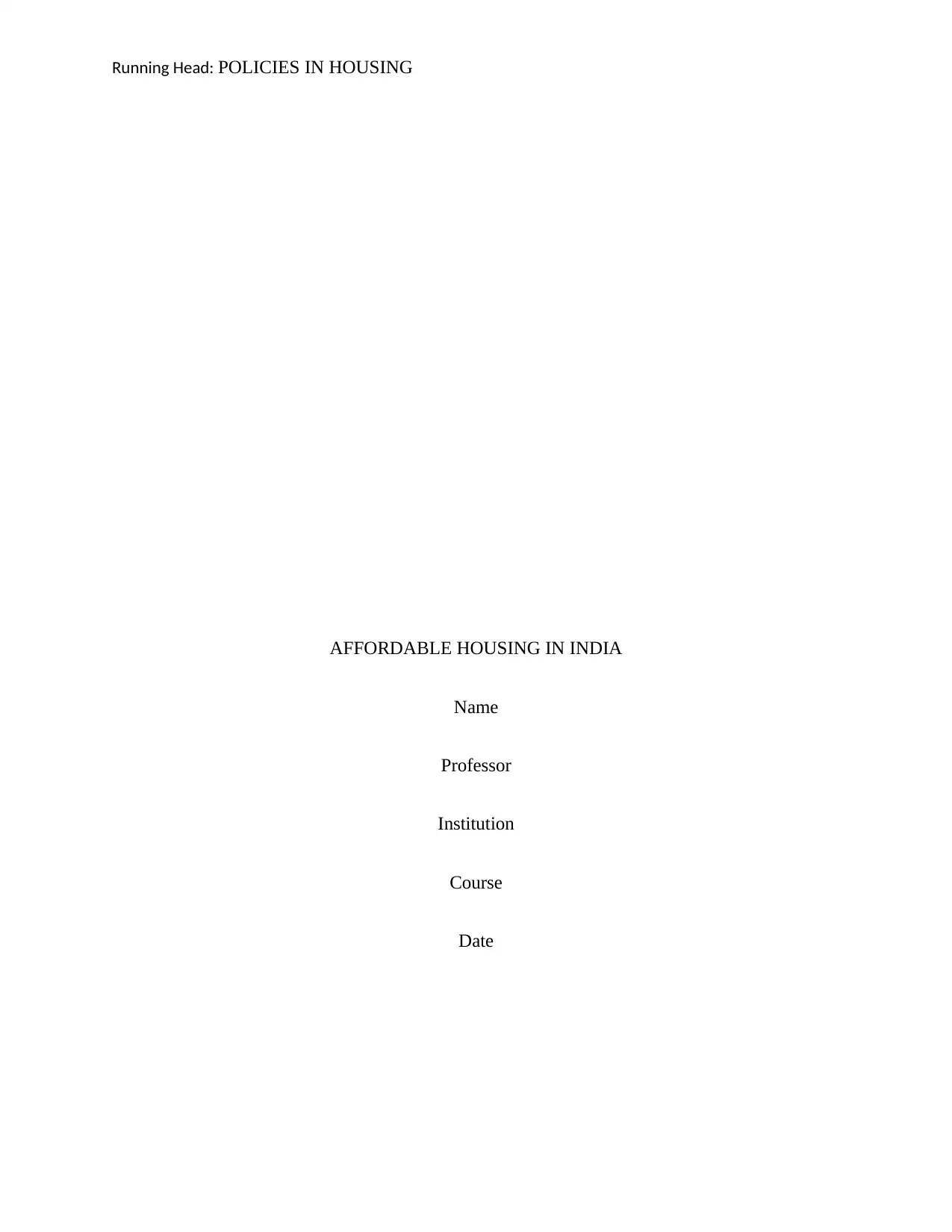
Running Head: POLICIES IN HOUSING
AFFORDABLE HOUSING IN INDIA
Name
Professor
Institution
Course
Date
AFFORDABLE HOUSING IN INDIA
Name
Professor
Institution
Course
Date
Paraphrase This Document
Need a fresh take? Get an instant paraphrase of this document with our AI Paraphraser

POLICIES IN HOUSING 2
Monopolistic competition
This is the model of a defective rivalry which is marked by numerous makers distributing
recognized items. The products are not perfect substitutes.in this kind of competition, a firm is a
price maker as it makes prices. Given that there is a coercive business, a monopolistic
competitive market will have some market power due to the differentiation of products. (Frazer,
2014).
A monopolistic competition has a demand curve that is downward sloping. The MR for a
pure monopoly is hence always not higher than the prices in the market since it can only
heighten the demand through bringing down the prices. Monopolistically competitive firms
maximize their gains or minimize their losses through the production of goods up to the point
whereby the marginal revenue will be equal to the MC in both the short run and also the long run
(Sharkey, 2012).
In the short run, a monopolistic market which is competitive will minimize its losses
through the production of the quantity that gives correspondence when marginal revenue is equal
to marginal cost. Given that average total cost is not above the market price, then there will be
some economic gains (Dimitrova & Schlee, 2013).
Monopolistic competition
This is the model of a defective rivalry which is marked by numerous makers distributing
recognized items. The products are not perfect substitutes.in this kind of competition, a firm is a
price maker as it makes prices. Given that there is a coercive business, a monopolistic
competitive market will have some market power due to the differentiation of products. (Frazer,
2014).
A monopolistic competition has a demand curve that is downward sloping. The MR for a
pure monopoly is hence always not higher than the prices in the market since it can only
heighten the demand through bringing down the prices. Monopolistically competitive firms
maximize their gains or minimize their losses through the production of goods up to the point
whereby the marginal revenue will be equal to the MC in both the short run and also the long run
(Sharkey, 2012).
In the short run, a monopolistic market which is competitive will minimize its losses
through the production of the quantity that gives correspondence when marginal revenue is equal
to marginal cost. Given that average total cost is not above the market price, then there will be
some economic gains (Dimitrova & Schlee, 2013).

POLICIES IN HOUSING 3
(Dimitrova & Schlee, 2013)
(Dimitrova & Schlee, 2013)
(Dimitrova & Schlee, 2013)
(Dimitrova & Schlee, 2013)
⊘ This is a preview!⊘
Do you want full access?
Subscribe today to unlock all pages.

Trusted by 1+ million students worldwide

POLICIES IN HOUSING 4
Given that the ATC is not below the market price, the industry will then be operating
under a loss which is equal to the ATC subtract from the price in the market then multiplied by
the quantity of the product. There will still be the minimization of losses through the production
of goods where the marginal revenue is equal to the marginal cost. However, in the long run the
industry will be required to either reverse the losses or exit the industry. The coal India Company
is an example of a company that enjoys the power of monopolistic competition (Dimitrova &
Schlee, 2013).
Given that the ATC is not below the market price, the industry will then be operating
under a loss which is equal to the ATC subtract from the price in the market then multiplied by
the quantity of the product. There will still be the minimization of losses through the production
of goods where the marginal revenue is equal to the marginal cost. However, in the long run the
industry will be required to either reverse the losses or exit the industry. The coal India Company
is an example of a company that enjoys the power of monopolistic competition (Dimitrova &
Schlee, 2013).
Paraphrase This Document
Need a fresh take? Get an instant paraphrase of this document with our AI Paraphraser
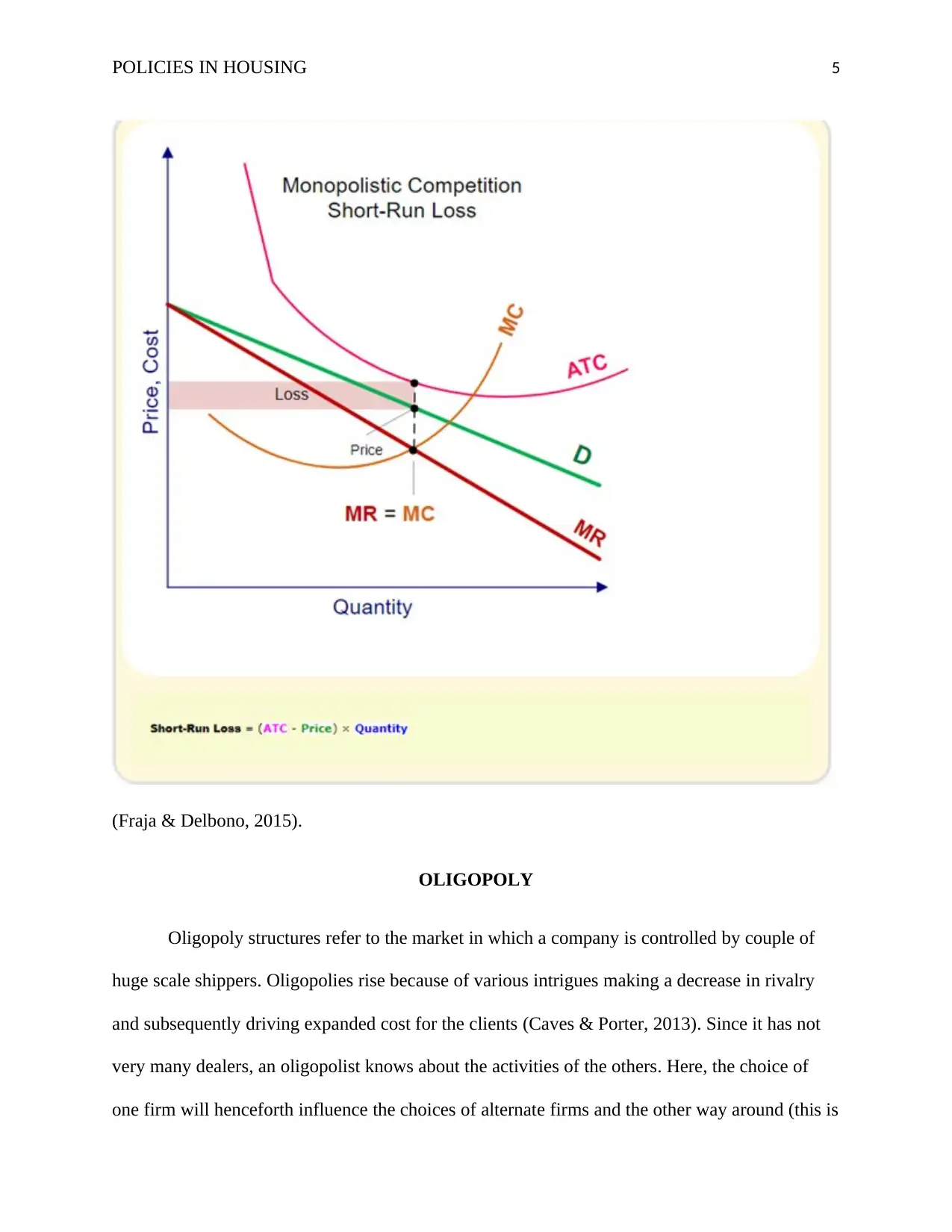
POLICIES IN HOUSING 5
(Fraja & Delbono, 2015).
OLIGOPOLY
Oligopoly structures refer to the market in which a company is controlled by couple of
huge scale shippers. Oligopolies rise because of various intrigues making a decrease in rivalry
and subsequently driving expanded cost for the clients (Caves & Porter, 2013). Since it has not
very many dealers, an oligopolist knows about the activities of the others. Here, the choice of
one firm will henceforth influence the choices of alternate firms and the other way around (this is
(Fraja & Delbono, 2015).
OLIGOPOLY
Oligopoly structures refer to the market in which a company is controlled by couple of
huge scale shippers. Oligopolies rise because of various intrigues making a decrease in rivalry
and subsequently driving expanded cost for the clients (Caves & Porter, 2013). Since it has not
very many dealers, an oligopolist knows about the activities of the others. Here, the choice of
one firm will henceforth influence the choices of alternate firms and the other way around (this is
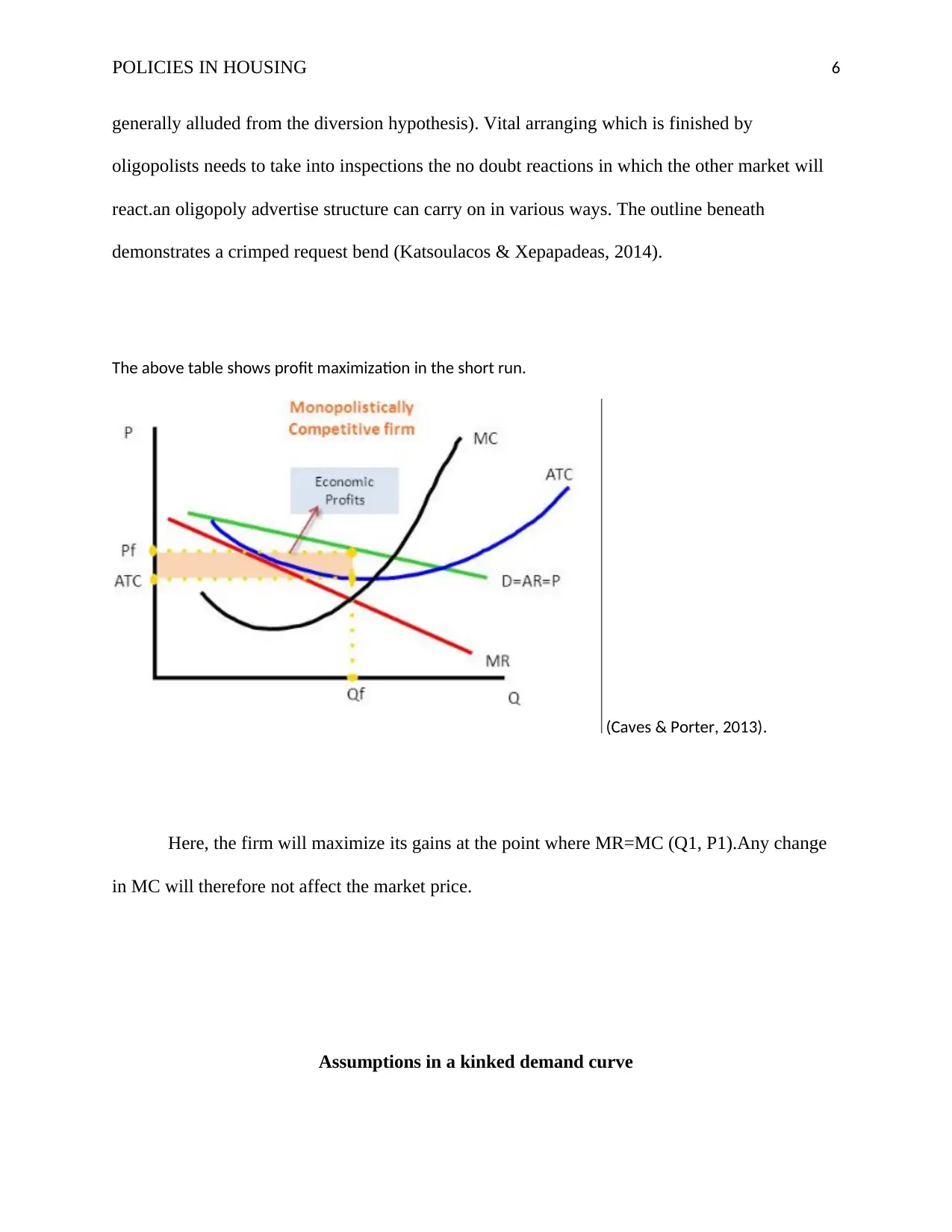
POLICIES IN HOUSING 6
generally alluded from the diversion hypothesis). Vital arranging which is finished by
oligopolists needs to take into inspections the no doubt reactions in which the other market will
react.an oligopoly advertise structure can carry on in various ways. The outline beneath
demonstrates a crimped request bend (Katsoulacos & Xepapadeas, 2014).
The above table shows profit maximization in the short run.
(Caves & Porter, 2013).
Here, the firm will maximize its gains at the point where MR=MC (Q1, P1).Any change
in MC will therefore not affect the market price.
Assumptions in a kinked demand curve
generally alluded from the diversion hypothesis). Vital arranging which is finished by
oligopolists needs to take into inspections the no doubt reactions in which the other market will
react.an oligopoly advertise structure can carry on in various ways. The outline beneath
demonstrates a crimped request bend (Katsoulacos & Xepapadeas, 2014).
The above table shows profit maximization in the short run.
(Caves & Porter, 2013).
Here, the firm will maximize its gains at the point where MR=MC (Q1, P1).Any change
in MC will therefore not affect the market price.
Assumptions in a kinked demand curve
⊘ This is a preview!⊘
Do you want full access?
Subscribe today to unlock all pages.

Trusted by 1+ million students worldwide
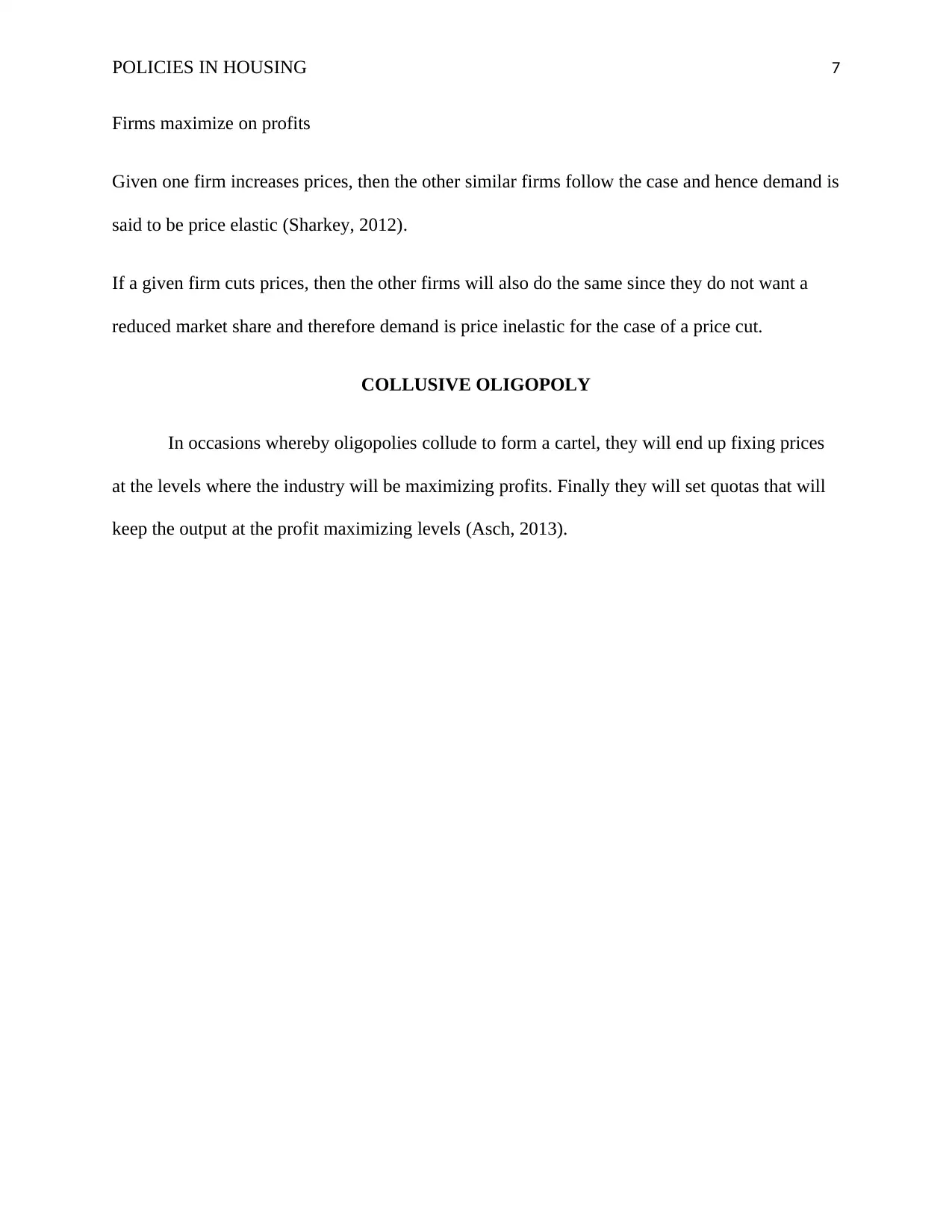
POLICIES IN HOUSING 7
Firms maximize on profits
Given one firm increases prices, then the other similar firms follow the case and hence demand is
said to be price elastic (Sharkey, 2012).
If a given firm cuts prices, then the other firms will also do the same since they do not want a
reduced market share and therefore demand is price inelastic for the case of a price cut.
COLLUSIVE OLIGOPOLY
In occasions whereby oligopolies collude to form a cartel, they will end up fixing prices
at the levels where the industry will be maximizing profits. Finally they will set quotas that will
keep the output at the profit maximizing levels (Asch, 2013).
Firms maximize on profits
Given one firm increases prices, then the other similar firms follow the case and hence demand is
said to be price elastic (Sharkey, 2012).
If a given firm cuts prices, then the other firms will also do the same since they do not want a
reduced market share and therefore demand is price inelastic for the case of a price cut.
COLLUSIVE OLIGOPOLY
In occasions whereby oligopolies collude to form a cartel, they will end up fixing prices
at the levels where the industry will be maximizing profits. Finally they will set quotas that will
keep the output at the profit maximizing levels (Asch, 2013).
Paraphrase This Document
Need a fresh take? Get an instant paraphrase of this document with our AI Paraphraser
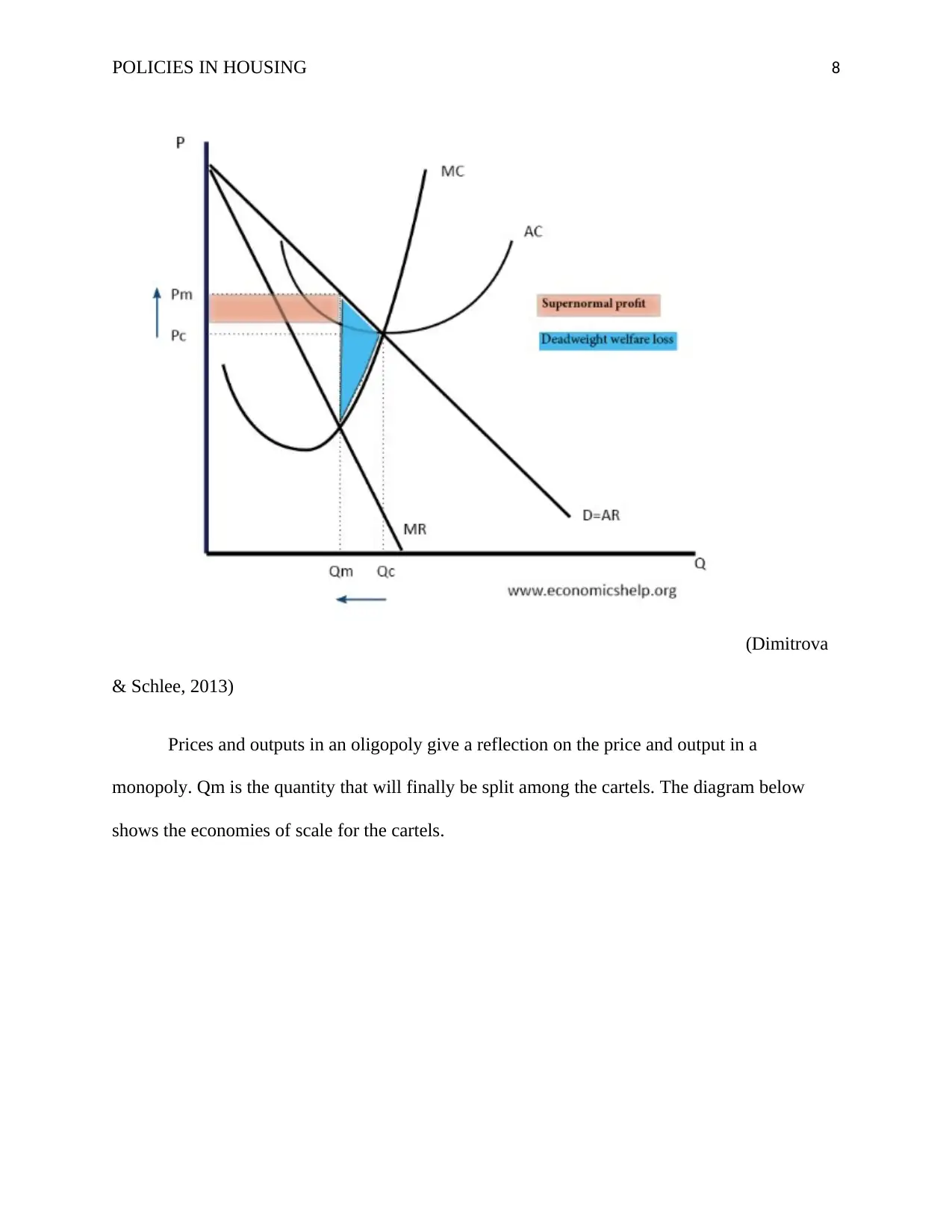
POLICIES IN HOUSING 8
(Dimitrova
& Schlee, 2013)
Prices and outputs in an oligopoly give a reflection on the price and output in a
monopoly. Qm is the quantity that will finally be split among the cartels. The diagram below
shows the economies of scale for the cartels.
(Dimitrova
& Schlee, 2013)
Prices and outputs in an oligopoly give a reflection on the price and output in a
monopoly. Qm is the quantity that will finally be split among the cartels. The diagram below
shows the economies of scale for the cartels.

POLICIES IN HOUSING 9
Efficiency of firms in oligopoly
The big firms enjoy the economies of scale, the relatively low average costs and therefore
the latter outweighs other inefficiencies.
The industries that are operating under a kinked demand curve will end up setting prices which
are higher than the marginal cost (Hay & Liu, 2015).
Firms can successfully collude and set prices which are higher than the marginal cost.in the case
where oligopolies are competitive, the prices will be lower and more allocative adequate.
In the case of a dynamic efficiency, industries have the profits which they can in turn use to
invest in new products (Fraja & Delbono, 2015).
Efficiency of firms in oligopoly
The big firms enjoy the economies of scale, the relatively low average costs and therefore
the latter outweighs other inefficiencies.
The industries that are operating under a kinked demand curve will end up setting prices which
are higher than the marginal cost (Hay & Liu, 2015).
Firms can successfully collude and set prices which are higher than the marginal cost.in the case
where oligopolies are competitive, the prices will be lower and more allocative adequate.
In the case of a dynamic efficiency, industries have the profits which they can in turn use to
invest in new products (Fraja & Delbono, 2015).
⊘ This is a preview!⊘
Do you want full access?
Subscribe today to unlock all pages.

Trusted by 1+ million students worldwide
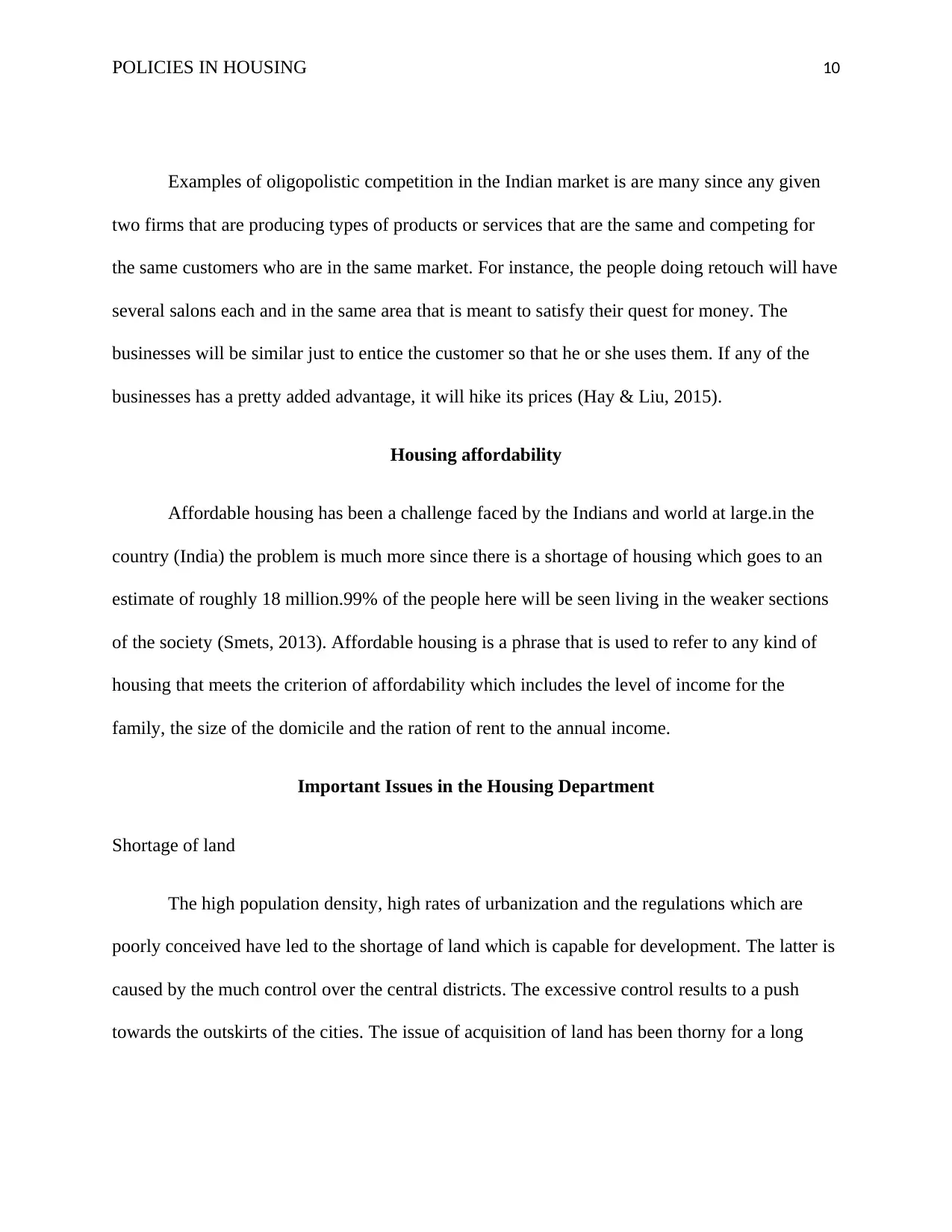
POLICIES IN HOUSING 10
Examples of oligopolistic competition in the Indian market is are many since any given
two firms that are producing types of products or services that are the same and competing for
the same customers who are in the same market. For instance, the people doing retouch will have
several salons each and in the same area that is meant to satisfy their quest for money. The
businesses will be similar just to entice the customer so that he or she uses them. If any of the
businesses has a pretty added advantage, it will hike its prices (Hay & Liu, 2015).
Housing affordability
Affordable housing has been a challenge faced by the Indians and world at large.in the
country (India) the problem is much more since there is a shortage of housing which goes to an
estimate of roughly 18 million.99% of the people here will be seen living in the weaker sections
of the society (Smets, 2013). Affordable housing is a phrase that is used to refer to any kind of
housing that meets the criterion of affordability which includes the level of income for the
family, the size of the domicile and the ration of rent to the annual income.
Important Issues in the Housing Department
Shortage of land
The high population density, high rates of urbanization and the regulations which are
poorly conceived have led to the shortage of land which is capable for development. The latter is
caused by the much control over the central districts. The excessive control results to a push
towards the outskirts of the cities. The issue of acquisition of land has been thorny for a long
Examples of oligopolistic competition in the Indian market is are many since any given
two firms that are producing types of products or services that are the same and competing for
the same customers who are in the same market. For instance, the people doing retouch will have
several salons each and in the same area that is meant to satisfy their quest for money. The
businesses will be similar just to entice the customer so that he or she uses them. If any of the
businesses has a pretty added advantage, it will hike its prices (Hay & Liu, 2015).
Housing affordability
Affordable housing has been a challenge faced by the Indians and world at large.in the
country (India) the problem is much more since there is a shortage of housing which goes to an
estimate of roughly 18 million.99% of the people here will be seen living in the weaker sections
of the society (Smets, 2013). Affordable housing is a phrase that is used to refer to any kind of
housing that meets the criterion of affordability which includes the level of income for the
family, the size of the domicile and the ration of rent to the annual income.
Important Issues in the Housing Department
Shortage of land
The high population density, high rates of urbanization and the regulations which are
poorly conceived have led to the shortage of land which is capable for development. The latter is
caused by the much control over the central districts. The excessive control results to a push
towards the outskirts of the cities. The issue of acquisition of land has been thorny for a long
Paraphrase This Document
Need a fresh take? Get an instant paraphrase of this document with our AI Paraphraser
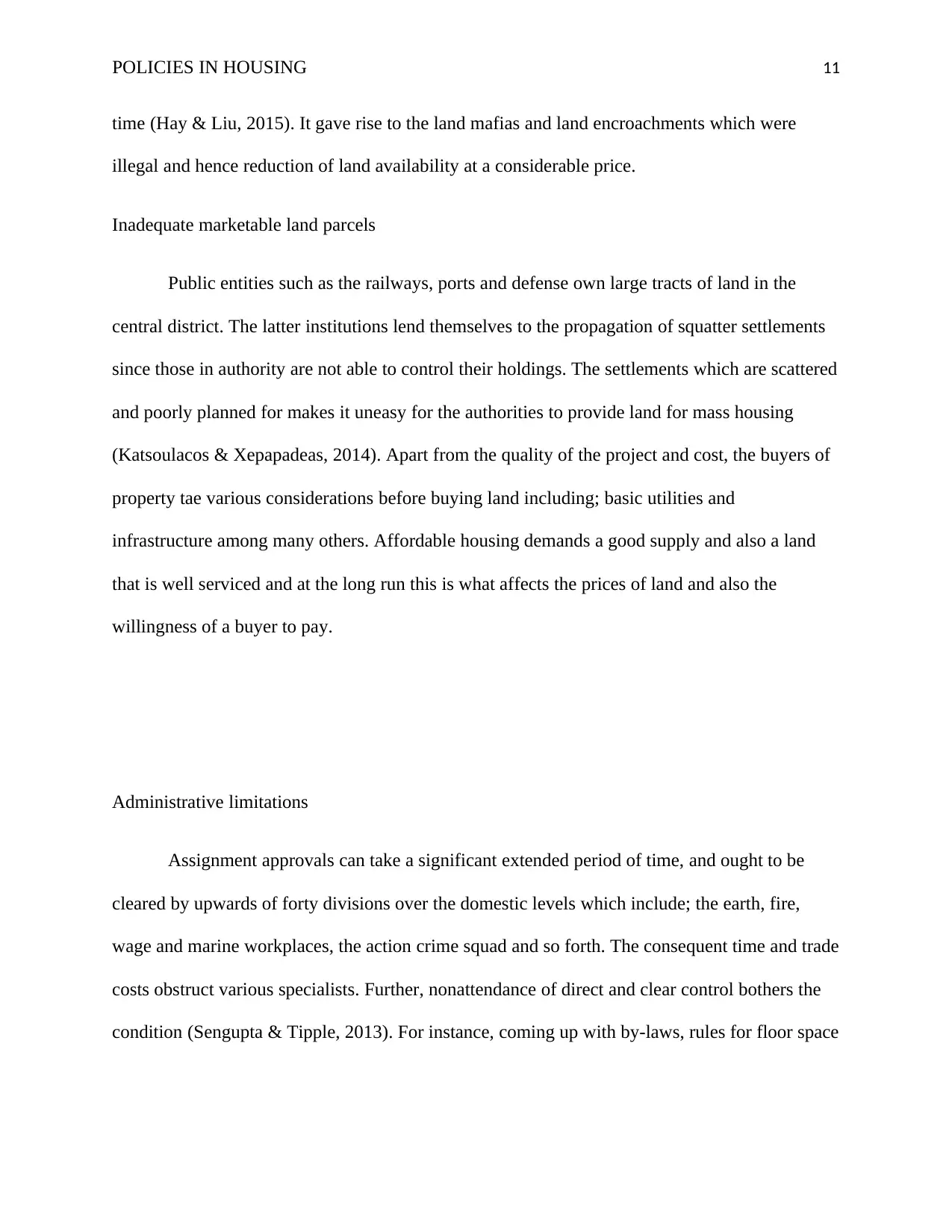
POLICIES IN HOUSING 11
time (Hay & Liu, 2015). It gave rise to the land mafias and land encroachments which were
illegal and hence reduction of land availability at a considerable price.
Inadequate marketable land parcels
Public entities such as the railways, ports and defense own large tracts of land in the
central district. The latter institutions lend themselves to the propagation of squatter settlements
since those in authority are not able to control their holdings. The settlements which are scattered
and poorly planned for makes it uneasy for the authorities to provide land for mass housing
(Katsoulacos & Xepapadeas, 2014). Apart from the quality of the project and cost, the buyers of
property tae various considerations before buying land including; basic utilities and
infrastructure among many others. Affordable housing demands a good supply and also a land
that is well serviced and at the long run this is what affects the prices of land and also the
willingness of a buyer to pay.
Administrative limitations
Assignment approvals can take a significant extended period of time, and ought to be
cleared by upwards of forty divisions over the domestic levels which include; the earth, fire,
wage and marine workplaces, the action crime squad and so forth. The consequent time and trade
costs obstruct various specialists. Further, nonattendance of direct and clear control bothers the
condition (Sengupta & Tipple, 2013). For instance, coming up with by-laws, rules for floor space
time (Hay & Liu, 2015). It gave rise to the land mafias and land encroachments which were
illegal and hence reduction of land availability at a considerable price.
Inadequate marketable land parcels
Public entities such as the railways, ports and defense own large tracts of land in the
central district. The latter institutions lend themselves to the propagation of squatter settlements
since those in authority are not able to control their holdings. The settlements which are scattered
and poorly planned for makes it uneasy for the authorities to provide land for mass housing
(Katsoulacos & Xepapadeas, 2014). Apart from the quality of the project and cost, the buyers of
property tae various considerations before buying land including; basic utilities and
infrastructure among many others. Affordable housing demands a good supply and also a land
that is well serviced and at the long run this is what affects the prices of land and also the
willingness of a buyer to pay.
Administrative limitations
Assignment approvals can take a significant extended period of time, and ought to be
cleared by upwards of forty divisions over the domestic levels which include; the earth, fire,
wage and marine workplaces, the action crime squad and so forth. The consequent time and trade
costs obstruct various specialists. Further, nonattendance of direct and clear control bothers the
condition (Sengupta & Tipple, 2013). For instance, coming up with by-laws, rules for floor space

POLICIES IN HOUSING 12
record, and zoning and change outlines of city neighborhood bodies as often as possible need
clearness and there are covering rules.
Inadequate marketable land parcels
Public institutions like ports and defense own large tracts of land in the central district.
The latter institutions lend themselves to the propagation of resident settlements since those in
authority are not able to control their holdings. The settlements which are scattered and poorly
planned for makes it uneasy for the authorities to provide land for mass housing (Katsoulacos &
Xepapadeas, 2014). Apart from the quality of the project and cost, the buyers of property tae
various considerations before buying land including; basic utilities and infrastructure among
many others. Affordable housing demands a good supply and also a land that is well serviced
and at the long run this is what affects the prices of land and also the willingness of a buyer to
pay (Smets, 2013).Universal confirmation on AH is fixated on two expansive subjects: a)
worldwide meanings of reasonableness, and b) global prescribed procedures and approach
intercessions in AH.
Purchase sensibility: an alternative measure of cabin moderateness is "purchase
sensibility" which checks if families can finance the buying of their homes. Normally,
acquisition sensibility is evaluated as an extent of cabin outlays (or month to month contract
portions) to month to month pay of the family. Purchase sensibility is exceedingly affected by
the ability to get the chance to contract and other home financing choices. The residency of the
home credit and the cost of the cabin structure affect purchase sensibility.
Rent payment sensibility and procurement moderateness expect that hotel and
fundamental non-lodging stock are legitimize items, obtaining a publicly appealing slightest
record, and zoning and change outlines of city neighborhood bodies as often as possible need
clearness and there are covering rules.
Inadequate marketable land parcels
Public institutions like ports and defense own large tracts of land in the central district.
The latter institutions lend themselves to the propagation of resident settlements since those in
authority are not able to control their holdings. The settlements which are scattered and poorly
planned for makes it uneasy for the authorities to provide land for mass housing (Katsoulacos &
Xepapadeas, 2014). Apart from the quality of the project and cost, the buyers of property tae
various considerations before buying land including; basic utilities and infrastructure among
many others. Affordable housing demands a good supply and also a land that is well serviced
and at the long run this is what affects the prices of land and also the willingness of a buyer to
pay (Smets, 2013).Universal confirmation on AH is fixated on two expansive subjects: a)
worldwide meanings of reasonableness, and b) global prescribed procedures and approach
intercessions in AH.
Purchase sensibility: an alternative measure of cabin moderateness is "purchase
sensibility" which checks if families can finance the buying of their homes. Normally,
acquisition sensibility is evaluated as an extent of cabin outlays (or month to month contract
portions) to month to month pay of the family. Purchase sensibility is exceedingly affected by
the ability to get the chance to contract and other home financing choices. The residency of the
home credit and the cost of the cabin structure affect purchase sensibility.
Rent payment sensibility and procurement moderateness expect that hotel and
fundamental non-lodging stock are legitimize items, obtaining a publicly appealing slightest
⊘ This is a preview!⊘
Do you want full access?
Subscribe today to unlock all pages.

Trusted by 1+ million students worldwide
1 out of 18
Related Documents
Your All-in-One AI-Powered Toolkit for Academic Success.
+13062052269
info@desklib.com
Available 24*7 on WhatsApp / Email
![[object Object]](/_next/static/media/star-bottom.7253800d.svg)
Unlock your academic potential
Copyright © 2020–2025 A2Z Services. All Rights Reserved. Developed and managed by ZUCOL.





